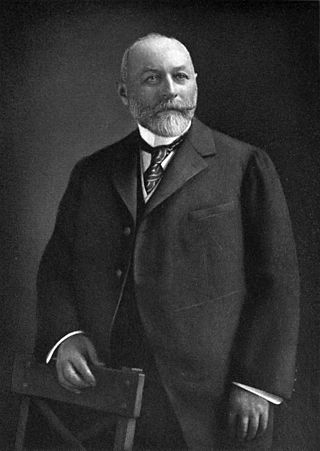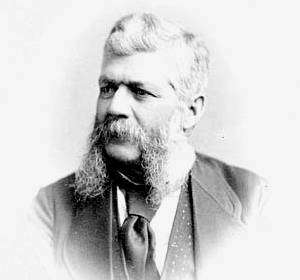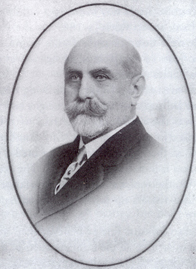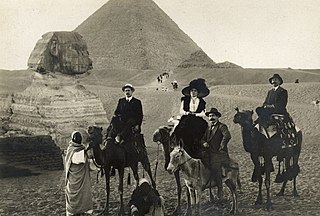Related Research Articles

Sir William Edmond Logan, FRSE FRS FGS, was a Canadian-born geologist and the founder and first director of the Geological Survey of Canada.

Abraham Pineo Gesner, ONB was a Canadian physician and geologist who invented kerosene. Gesner was born in Cornwallis, Nova Scotia and lived much of his life in Saint John, New Brunswick. He died in Halifax, Nova Scotia. He was an influential figure in the development of the study of Canadian geology and natural history.

Oil sands, tar sands, crude bitumen, or bituminous sands, are a type of unconventional petroleum deposit. Oil sands are either loose sands or partially consolidated sandstone containing a naturally occurring mixture of sand, clay, and water, soaked with bitumen, a dense and extremely viscous form of petroleum.

Imperial Oil Limited is a Canadian petroleum company. It is Canada's second-biggest integrated oil company. It is majority owned by American oil company ExxonMobil with around 69.6 percent ownership stake in the company. It is a significant producer of crude oil, diluted bitumen and natural gas, Canada's major petroleum refiner, a key petrochemical producer and a national marketer with coast-to-coast supply and retail networks. It supplies Esso-brand service stations.

Petrolia is a town in southwestern Ontario, Canada. It is part of Lambton County and is surrounded by Enniskillen Township. It is billed as "Canada's Victorian Oil Town" and is often credited with starting the oil industry in North America, a claim shared with the nearby town of Oil Springs.

Thomas Sterry Hunt was an American geologist and chemist.

Alexander Murray, was a Scottish geologist. Murray is best known for his career with the Geological Survey of Canada and the Geological Survey of Newfoundland.
Petroleum production in Canada is a major industry which is important to the economy of North America. Canada has the third largest oil reserves in the world and is the world's fourth largest oil producer and fourth largest oil exporter. In 2019 it produced an average of 750,000 cubic metres per day (4.7 Mbbl/d) of crude oil and equivalent. Of that amount, 64% was upgraded from unconventional oil sands, and the remainder light crude oil, heavy crude oil and natural-gas condensate. Most of Canadian petroleum production is exported, approximately 600,000 cubic metres per day (3.8 Mbbl/d) in 2019, with 98% of the exports going to the United States. Canada is by far the largest single source of oil imports to the United States, providing 43% of US crude oil imports in 2015.

Herman Frasch [or Hermann Frasch] was a chemist, mining engineer and inventor known for his work with petroleum and sulfur.

James Miller Williams was a Canadian-American businessman and politician. Williams is best known for establishing the first commercially successful oil well in 1858 and igniting the first oil boom in North America. Williams is commonly viewed as the father of the petroleum industry in Canada.

Oil Springs is a village in Lambton County, Ontario, Canada, located along Former Provincial Highway 21 south of Oil City. The village, an enclave within Enniskillen Township, is the site of North America's first commercial oil well. It is home to the Oil Museum of Canada.
The Canadian petroleum industry arose in parallel with that of the United States. Because of Canada's unique geography, geology, resources and patterns of settlement, however, it developed in different ways. The evolution of the petroleum sector has been a key factor in the history of Canada, and helps illustrate how the country became quite distinct from her neighbour to the south.

John Henry Fairbank was variously a surveyor, oilman, inventor, banker, politician and fire chief in Lambton County, Ontario. Fairbank is best known for his invention of the jerker-line pumping system, which quickly spread across the world its introduction in the mid-1860s. Fairbank Oil, established by Fairbank in 1861, is the oldest continually operating petroleum company, and the company's property, known as the "First Commercial Oil Field," is included in the List of National Historic Sites of Canada in Ontario.
The Shell Scotford Upgrader is an oilsand upgrader, a facility which processes crude bitumen from oil sands into a wide range of synthetic crude oils. The upgrader is owned by Athabasca Oil Sands Project (AOSP), a joint venture of Shell Canada Energy (60%), Marathon Oil Sands L.P. (20%) and Chevron Canada Limited (20%). The facility is located in the industrial development of Scotford, just to the northeast of Fort Saskatchewan, Alberta in the Edmonton Capital Region.

William Henry McGarvey was a Canadian business magnate, entrepreneur and politician. McGarvey is best known for his exploits in Galicia, where he operated a highly successful petroleum company. McGarvey was one of the most successful "foreign drillers" of Petrolia, becoming a multimillionaire before the outbreak of the First World War destroyed his business.

Below is a brief timeline covering the history of the petroleum industry Alberta and its predecessor states.

Jacob Lewis Englehart was a Canadian-American business magnate, entrepreneur and philanthropist. Englehart is best known for his role in the formation of Imperial Oil in 1880 to combat the growing influence of John D. Rockefeller's Standard Oil. Englehart was one of the most successful oil refiners in Canada during the 1800's and oversaw the completion of the Temiskaming and North Ontario Railway.

Hugh Nixon Shaw is an Irish-Canadian oil producer and businessman. Shaw is best known for being misidentified as the discoverer of the Shaw well, Canada's first oil gusher, on January 16, 1862.
John Shaw was an American oil driller, businessman and photographer. Shaw is best known for striking Canada's first oil gusher at Oil Springs on January 16, 1862. Shaw's oil gusher marked the beginning of the first oil boom in Enniskillen Township, as speculators rushed to Oil Springs seeking similar fortunes.

The International Drillers is the name given to the more than 500 drillers from Lambton County who worked in oil fields across the world between December 1873 to the mid-1940s. Many of the International Drillers grew up learning the oil business in Enniskillen County and provided the skilled labour, expertise and technology necessary for the development of the global petroleum industry.
References
- ↑ Gray, Earle. (2008). Ontario's petroleum legacy : the birth, evolution and challenges of a global industry. Edmonton: Heritage Community Foundation. p. 14. ISBN 978-1-4593-3970-5. OCLC 842999352.
- 1 2 Burr, Christina. (2006). Canada's Victorian Oil Town : the Transformation of Petrolia from Resource Town into a Victorian Community. Montreal, Kingston, London and Ithaca: McGill-Queen's University Press. p. 71. ISBN 978-0-7735-7590-5. OCLC 951204013.
- ↑ "Story of Oil | Enniskillen Township" . Retrieved 2020-06-02.
- ↑ Taylor, Graham D. (2019). Imperial standard : Imperial Oil, Exxon, and the Canadian oil industry from 1880. Calgary, Alberta, Canada: University of Calgary Press. pp. 22–23. ISBN 978-1-77385-036-8. OCLC 1087508620.
- 1 2 3 4 Burr, Christina. (2006). Canada's Victorian Oil Town : the Transformation of Petrolia from Resource Town into a Victorian Community. Montreal, Kingston, London and Ithaca: McGill-Queen's University Press. p. 57. ISBN 978-0-7735-7590-5. OCLC 951204013.
- 1 2 Gray, Earle. (2005). The great Canadian oil patch : the petroleum era from birth to peak. Edmonton: JuneWarren Pub. p. 21. ISBN 0-9737342-0-5. OCLC 60679720.
- 1 2 Gray, Earle. (2008). Ontario's petroleum legacy : the birth, evolution and challenges of a global industry. Edmonton: Heritage Community Foundation. p. 17. ISBN 978-1-4593-3970-5. OCLC 842999352.
- ↑ Burr, Christina. (2006). Canada's Victorian Oil Town : the Transformation of Petrolia from Resource Town into a Victorian Community. Montreal, Kingston, London and Ithaca: McGill-Queen's University Press. p. 72. ISBN 978-0-7735-7590-5. OCLC 951204013.
- ↑ May, Gary. (1998). Hard oiler! : the story of canadians' quest for oil at home and abroad. Toronto and Oxford: Dundurn. p. 29. ISBN 978-1-4597-1312-3. OCLC 1127560811.
- 1 2 May, Gary. (1998). Hard oiler! : the story of canadians' quest for oil at home and abroad. Toronto and Oxford: Dundurn. p. 30. ISBN 978-1-4597-1312-3. OCLC 1127560811.
- ↑ Drummond, Ian. (1987). Progress without Planning : the Economic History of Ontario from Confederation to the Second World War. Toronto, Buffalo and London: University of Toronto Press. p. 93. ISBN 978-1-4426-5395-5. OCLC 992490265.
- ↑ Gray, Earle. (2005). The great Canadian oil patch : the petroleum era from birth to peak. Edmonton: JuneWarren Pub. p. 22. ISBN 0-9737342-0-5. OCLC 60679720.
- 1 2 Gray, Earle. (2008). Ontario's petroleum legacy : the birth, evolution and challenges of a global industry. Edmonton: Heritage Community Foundation. p. 18. ISBN 978-1-4593-3970-5. OCLC 842999352.
- ↑ Gray, Earle. (2005). The great Canadian oil patch : the petroleum era from birth to peak. Edmonton: JuneWarren Pub. p. 2005. ISBN 0-9737342-0-5. OCLC 60679720.
- ↑ Gray, Earle. (2008). Ontario's petroleum legacy : the birth, evolution and challenges of a global industry. Edmonton: Heritage Community Foundation. p. 20. ISBN 978-1-4593-3970-5. OCLC 842999352.
- ↑ Burr, Christina. (2006). Canada's Victorian Oil Town : the Transformation of Petrolia from Resource Town into a Victorian Community. Montreal, Kingston, London and Ithaca: McGill-Queen's University Press. p. 15. ISBN 978-0-7735-7590-5. OCLC 951204013.
- ↑ Taylor, Graham D., 1944- (2019). Imperial standard : Imperial Oil, Exxon, and the Canadian oil industry from 1880. Calgary, Alberta, Canada: University of Calgary Press. pp. 23–24. ISBN 978-1-77385-036-8. OCLC 1087508620.
{{cite book}}: CS1 maint: multiple names: authors list (link) - 1 2 3 4 5 6 7 8 "Death of a Character". The Ottawa Citizen. November 3, 1866.
- 1 2 Chambers, Lori. (1997). Married Women and the Law of Property in Victorian Ontario. Toronto, Buffalo and London: University of Toronto Press. pp. 66–67. ISBN 978-1-4426-7709-8. OCLC 944177986.
- ↑ Gray, Earle. (2005). Ontario's petroleum legacy : the birth, evolution and challenges of a global industry. Edmonton: Heritage Community Foundation. pp. 21–22. ISBN 978-1-4593-3970-5. OCLC 842999352.
- ↑ May, Gary. (1998). Hard oiler! : the story of canadians' quest for oil at home and abroad. Toronto and Oxford: Dundurn. p. 37. ISBN 978-1-4597-1312-3. OCLC 1127560811.
- ↑ "Charles Nelson Tripp - Canadian Petroleum Hall of Fame". www.canadianpetroleumhalloffame.ca. Retrieved 2020-06-02.
- ↑ "Henry Tripp - Canadian Petroleum Hall of Fame". www.canadianpetroleumhalloffame.ca. Retrieved 2020-06-02.
- ↑ "Canada Post - Collecting". Archived from the original on 2012-10-09. Retrieved 2011-04-09.